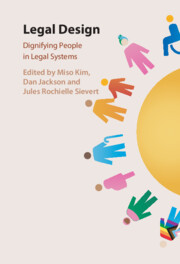Book contents
- Legal Design
- Legal Design
- Copyright page
- Dedication
- Contents
- Figures and Tables
- Contributors
- Foreword
- Acknowledgments
- Introduction
- I Why Legal Design
- II What Legal Design Can Do
- III How Legal Design Works
- 12 Designers, Lawyers, and Students
- 13 Teaching the Legal Inventors of the Future
- 14 The Stanford Legal Design Lab
- 15 Graphically Novel
- 16 Building Technology with(out) People
- 17 International Courts and Design
- 18 James v Birnmann
- 19 The ReInvent Law Archive
- 20 The Open Law Lab Blog
- 21 Disciplinarity and the Modes of Legal Design
- IV Where Legal Design Goes
- Conclusion
- Index
- References
12 - Designers, Lawyers, and Students
A Decade of NuLawLab Experience
from III - How Legal Design Works
Published online by Cambridge University Press: 19 December 2024
- Legal Design
- Legal Design
- Copyright page
- Dedication
- Contents
- Figures and Tables
- Contributors
- Foreword
- Acknowledgments
- Introduction
- I Why Legal Design
- II What Legal Design Can Do
- III How Legal Design Works
- 12 Designers, Lawyers, and Students
- 13 Teaching the Legal Inventors of the Future
- 14 The Stanford Legal Design Lab
- 15 Graphically Novel
- 16 Building Technology with(out) People
- 17 International Courts and Design
- 18 James v Birnmann
- 19 The ReInvent Law Archive
- 20 The Open Law Lab Blog
- 21 Disciplinarity and the Modes of Legal Design
- IV Where Legal Design Goes
- Conclusion
- Index
- References
Summary
This chapter details ten years of the methods we have deployed in the NuLawLab’s project work with community members, organizations, and legal entities. We begin by examining our approach to interdisciplinary collaboration as it has evolved over time, followed by detailing one such partnership, Stable Ground. We next tackle aspects of participatory collaborative design by examining how we created our RePresent games. The third suite of methods we detail is service design and how we used those concepts to aid survivors of domestic violence during the COVID-19 pandemic. We close by distilling each experience into a handful of takeaways that we hope will prove useful to other legal designers as they consider applying these methods in their work.
Keywords
- Type
- Chapter
- Information
- Legal DesignDignifying People in Legal Systems, pp. 179 - 207Publisher: Cambridge University PressPrint publication year: 2024

